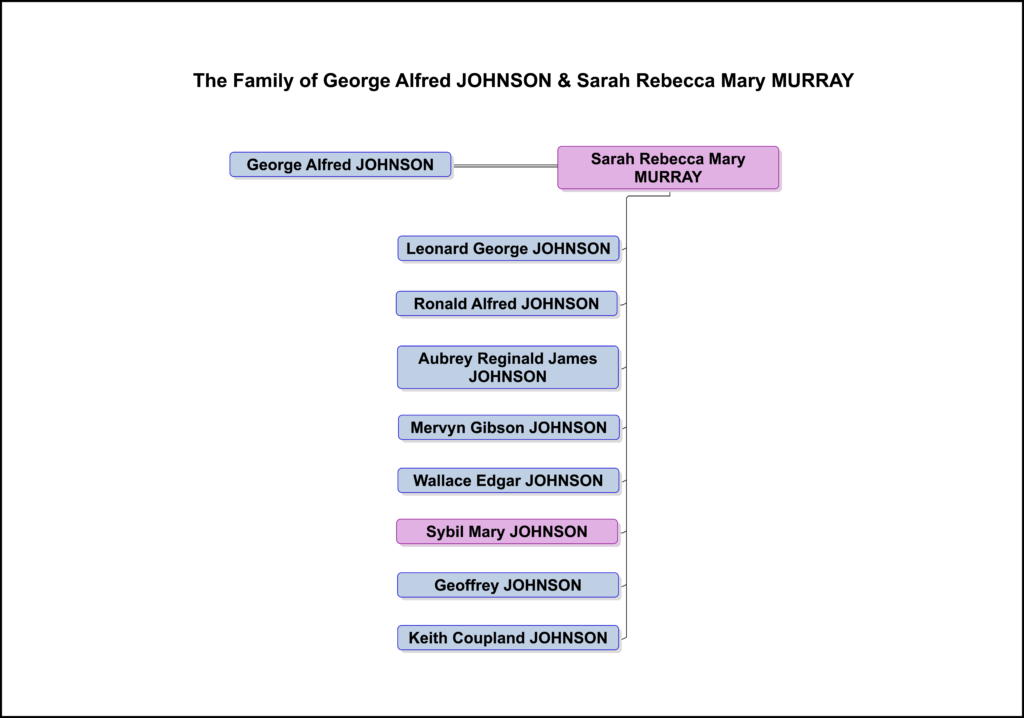
George Alfred (Alf) JOHNSON
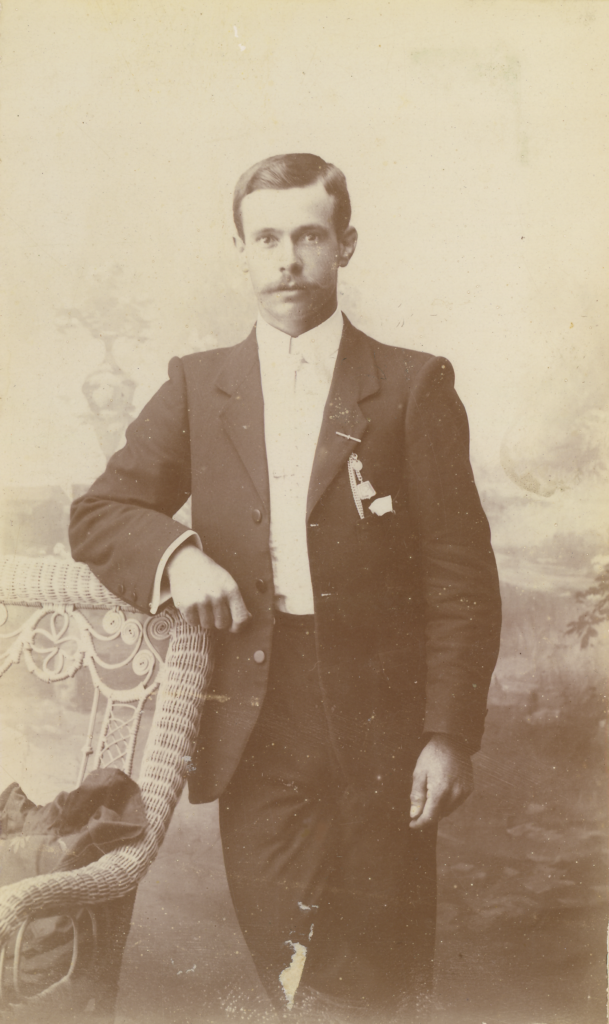
England
George Alfred Johnson, better known as Alf so as not to confuse him with his father George, was the youngest child of seven children of George Johnson And Eliza Stephenson Coupland. He was born in the village of Broughton, Lincolnshire on 3 October, 1883. He was baptised at the Primitive Methodist Chapelon 24 october of the same year. The Primitive Chapel was built in 1841 and later a Wesleyan Methodist Chapel was built in 1845. This Primitive Chapel was closed and sold in 1958 and later demolished.
In 1885, Kelly’s Directory listed a few interesting facts about Broughton of which I have supplied some extracts below:
“Broughton (with hamlets of Castlethorpe, Gokewell and Manby) is a large parish and village, 4 miles north-west from Brigg, 3 1/2 miles north from Scawby station on the Sheffield and Lincolnshire railway and 3 from Appleby station on the Manchester, Sheffield and Lincolnshire railway. Part of the parish is governed by a Local Board of 9 members. The church of St. Mary has a square tower, pinnacles and 5 bells; is built upon the foundations of a Norman church, parts of which have been recently discovered during the progress of the restoration in 1884. At the north is the Anderson chapel, containing some good monuments of the Anderson family dating from 1660: there is also a very fine altar tomb of the fourteenth century. The register dates from the year 1538. Her are the chapels for the Wesleyans and Primitive Methodists. Brought seems to have been a Roman settlement. The soil is principally sandy; subsoil, limestone and chief crops are wheat, barley and oats. The population for the district in 1881 was 1,308, of which 1,094 are in the Local Board District.”
There was a National School, erected by the late Earl of Yarborough, for 237 children, with an average attendance of 150; the school was supported by voluntary contributions, government grant and school pence. Possibly Alf’s older siblings attended this school.
Some the businesses in Broughton were: an insurance agent; carriers; blacksmith; beer retailers; tanners; tailor; coal dealer; millers; shoe makers; butchers and shopkeepers.
Australia
As mentioned previously in his father’s story, the family decided to leave England and sailed to Queensland, Australia in October, 1887 when Alf was aged three years. Details of the voyage and other information are also listed in the George Johnson and Eliza Stephenson Coupland story. The family arrived at Maryborough in January, 1888 and travelled to the Hodgson area in western Queensland.
The Hodgson Provisional School opened on 1 February, 1876 and became the Hodgson State School on 1 September, 1884. In his Hodgson School exercise book of the month of April 1897, when Alf was nearly 14 years old, he shows his neat penmanship with his down-strokes heavy and up-strokes light. He also excels at arithmetic and grammar. Examples of these are below.
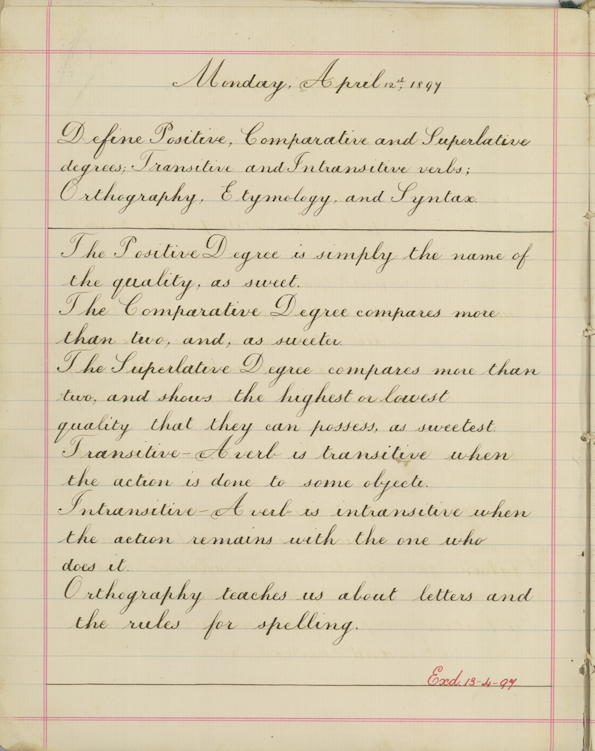
Example of grammar.
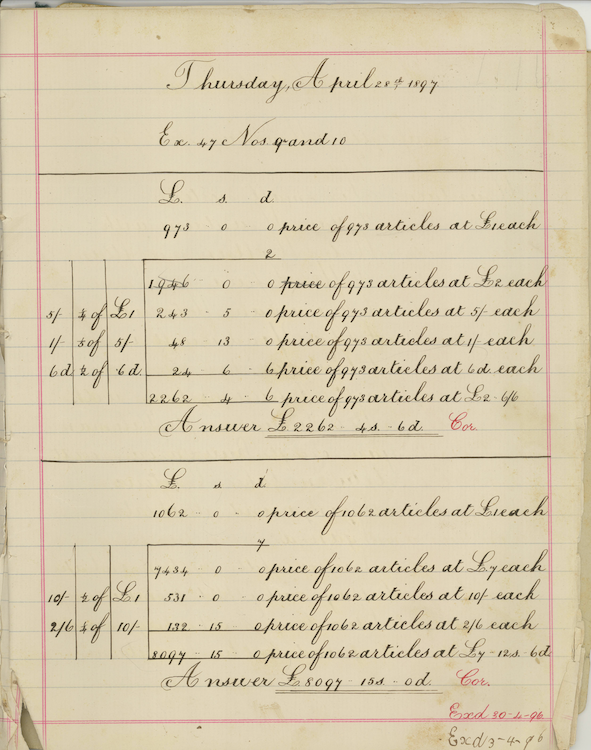
Example of mathematics.
There is a fairly detailed account of Alf’s life described by his son Geoff Johnson in his book “Mate’s Story”. As many readers of this story will not have the book, I will write much of the story below and intersperse it with details and some photos I have found.
‘My father attended the Hodgson State school until he was old enough to go to work and then obtained employment from Mr. Ben Rayner doing casual farm work. Mr Rayner was a man of note in the Hodgson district, so much so, that he was known as the ‘Mayor of Hodgson’, being the owner of the General Store and Hotel, (in those days there were three Hotels, I believe), and also considerable farming land. However, my father was not content at this type of work and soon sought and obtained work in the station shearing sheds where he learned to shear and soon was following this work out to the Cunnamulla and Charleville districts as well as the local stations of Mt. Abundance and Bindango, Eurella and Amby Downs.
The era of blade shearing had passed and engine driven shearing machines was in full swing. Some of the shearing sheds were fitted with steam power and as Grandfather (George Johnson) had a steam-engine driver’s ticket, they were often employed at the same shed together.
‘Mate’s Story’ by Geoff Johnson.
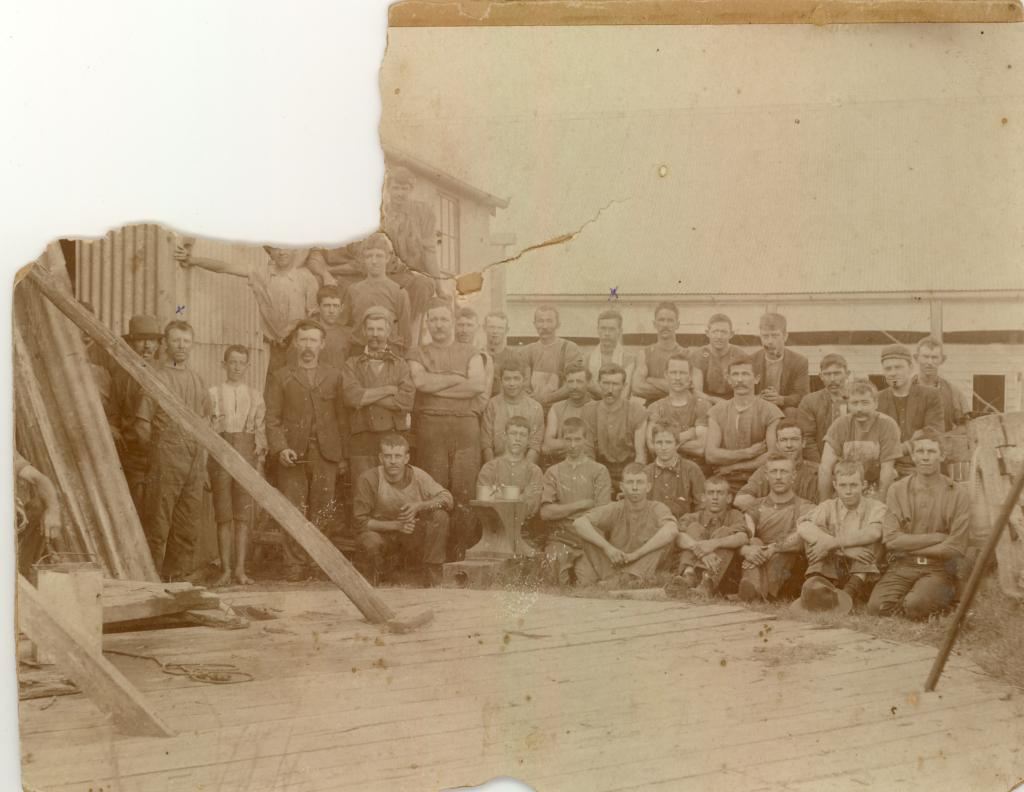
William Gibson MURRAY – 2nd from left (brother-in-law to Alf & arrow over head)
Alf JOHNSON back row (7th from right & arrow over head).
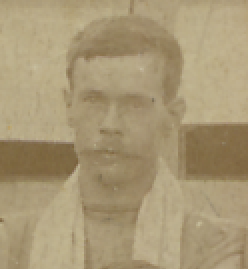
Alf also obtained, later in 1920, a Third Class Engine driver license.
‘Push bikes were the main means of travel and my father was one of the better riders in the locality and won a medal on winning a race from Hodgson to Roma. He would start off from Hodgson siding as the train left the railway station about three quarters of a mile south. He had to cross the railway line at the Meadow Bank gates (about half of the journey) and he would always try to beat the train to this point so as to make h final half of the journey at a much easier pace. If he failed to do this then he would have a much harder task to arrive before the train to Roma.’
‘Mate’s Story’ by Geoff Johnson.
The bike race Geoff mentions in his book was sponsored by the Red Bird Bicycle company. As mentioned in the Western Star & Roma Advertiser (16 April, 1904), it was a time-handicap road race from Mr. B. Rayner’s residence at Hodgson to the finishing point at the lamp-post at the intersection of McDowall and Hawthorne Streets in Roma. The paper mentions that the race took place on Wednesday 27 April, 1904, with thirteen men competing for a medal presented by the Red Bird Bicycle Company, and other prizes although only nine men competed on the day. Alf was on a 2 minute handicap with others ranging from zero to 5 minutes.
In Saturday’s 30 April edition, the race and results were written as thus:
Considerable local interest was manifested in a time handicap bicycle road race, arranged by Mr. M. J. Johnston, which took place on Wednesday afternoon last, for a medal presented by the Red Bird Co. The starting point was at Hodgson, the first land being dispatched punctually at 4 o’clock. There were nine competitors, the winner turning up in A.Johnson, of Hodgson, who covered the distance to Roma, about 11 miles, in 40 minutes, his handicap being 2 minutes. F. Schormann, who had 4 minutes start, was second, his time being 42 minutes, and Walpole, with a handicap of 2 minutes, was third, covering the distance in 40 1/5 minutes. Besides a medal for first prize, two lamps were awarded to the second and third men, and it may be mentioned that the three prize winners all rode Red Bird bicycles. The time in which the distance was covered, especially consider the stat of the road, is regarded as very creditable, and so much interest was taken in the event that further contests are likely to be arranged.
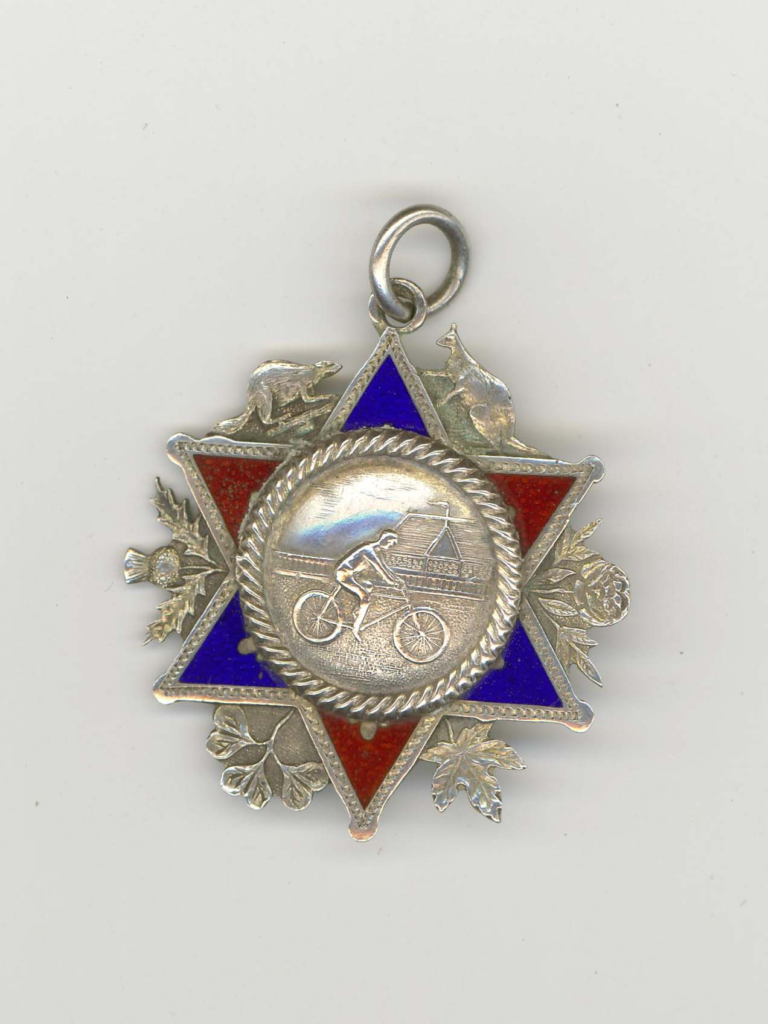
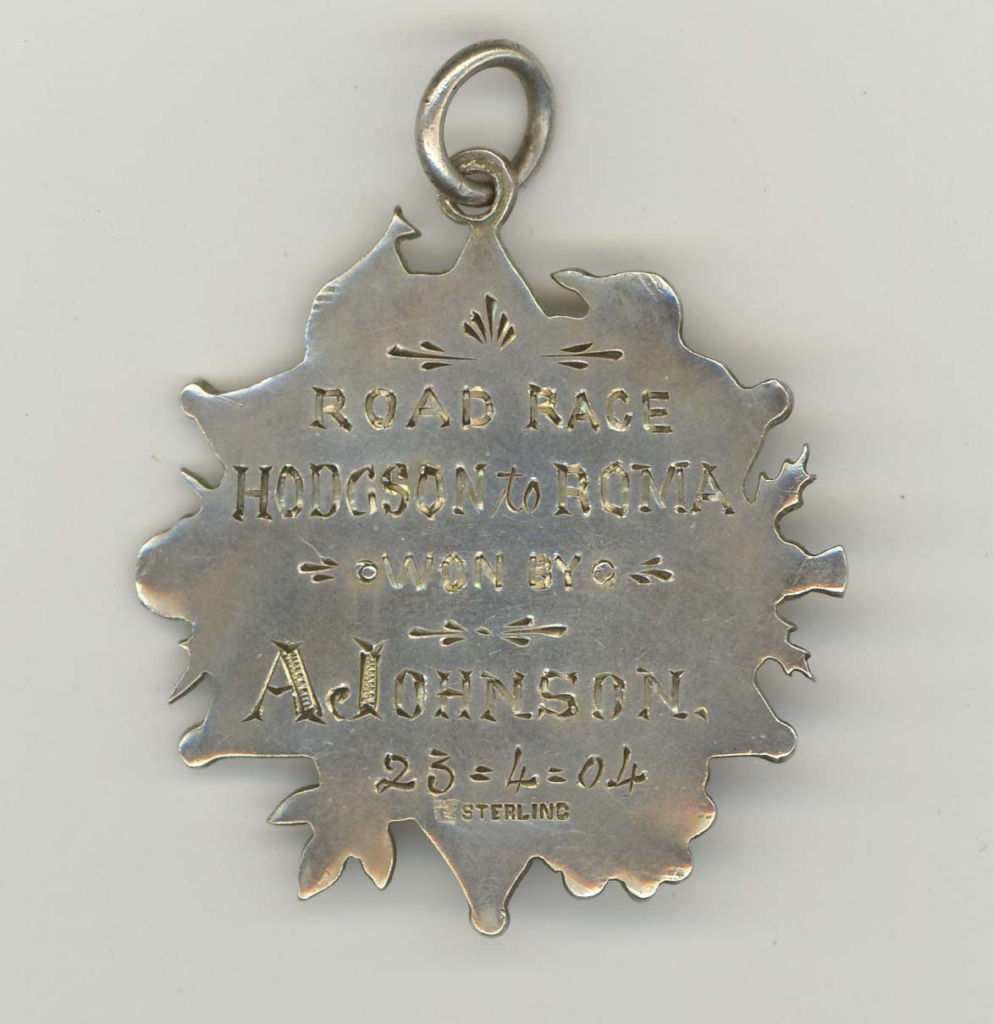
As mentioned in his father’s story – Alf, his father George, and his older brother Fred, had selected land on the upper Dargal Creek in the early 1900’s. In the Western Star & Roma Advertiser edition of 12 November, 1904, Alf ‘s application for land was accepted by the Land Court and he received 320 acres, portions 128v and 129v.
‘When shearing was not in progress, the time was taken up in clearing the land. The only means to do this was with the grubber (mattock) simply by just digging round the tree and cutting it’s roots until it fell over, and burn it up. Two horses and a three wheeled plough were purchased from a farmer near Roma, the horses being good and well handled. A long narrow strip of land was cleared and ploughing commenced. Dad would work at one end and Grandpa at the other and after the first furrow was ploughed the horses would follow it to the other end where they’d be turned around to start ploughing in the opposite direction. If the plough got stuck under a root or stump, the horses would stop and whoever was closest to the motionless plough would have to go and set things right to recommence the ploughing.
‘Mate’s Story’ by Geoff Johnson.
So Alf would have been kept very busy with helping his father to clear their land and during the shearing season supplementing the income with working at different properties shearing sheep.
Sarah Rebecca Mary MURRAY
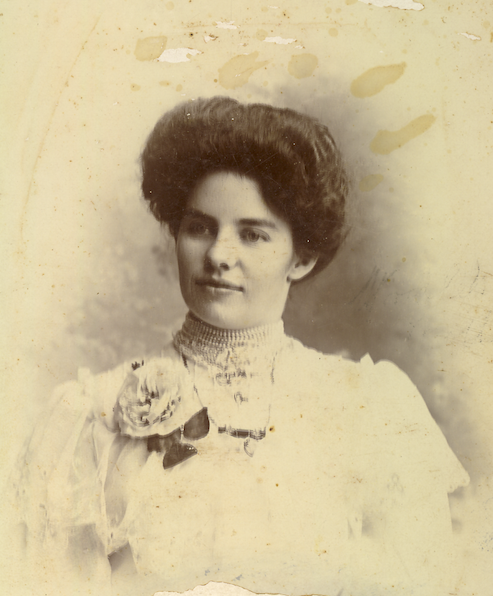
Sarah Rebecca Mary Murray was born at Hemmant in Brisbane on 5 November, 1887 to James Murray and Emily Gibson. She was the first daughter and fourth child in the family of seven.
Sarah or Sara
There is a question about the spelling of Sarah’s name. On some official documents she is named ‘Sara’ and on others, ‘Sarah’. I will list them below to show how confusing it can be:
Sarah – On her birth and death certificates; her baptism certificate; baptism of her daughter, Sybil; marriage certificate of daughter, Sybil; her gravestone and her will. She also wrote Sarah Johnson in her own hand in my mother, Sybil’s birthday book with her address at Enoggera.
Sara – On her marriage certificate; birth certificate of daughter, Sybil; in letters addressed to her from her mother and sisters, on postcards from other members of the extended families and also on Alf’s wedding ring.
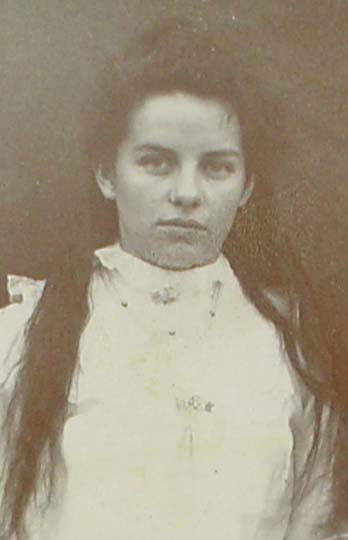
Courtesy of Lorna Murray.
I believe ‘Sarah’ was her official name and ‘Sara’ was the affectionate family name. Also her name was pronounced ‘Sarah’ not ‘Sara’. I only ever remember Gran being referred to as Sarah. I have used the name Sarah in this history.
As mentioned in her parent’s story, Sarah would probably have spent her early childhood in Brisbane. The first mention of the family coming to the Hodgson area was in 1891, when her father James, applied for and was granted a block of land in Hodgson. Sarah would have probably attended the Hodgson State School several years behind Alf. While at home, Sarah being the middle child, but oldest daughter in a family of seven, would have been taught at an early age, washing, ironing, cooking as well as household chores. Sarah was also an accomplished needlewoman, being proficient in making clothes, crochet, knitting and embroidery (especially table linen). Luckily, having so many older brothers, she probably wouldn’t have had to do much outside work.
Marriage
Sarah and Alf would have socialised at dances in Hodgson, tennis matches and other social occasions around the Hodgson area. 1908 was a big year for the Murray family. Sarah’s younger sister Annie was married in July and her older brother James Frederick Malcolm was married In October. Sarah and Alf were married on 10 December 1908 at the Methodist Parsonage in Roma. Her sister Rose Mary and brother George Henry were the witnesses.
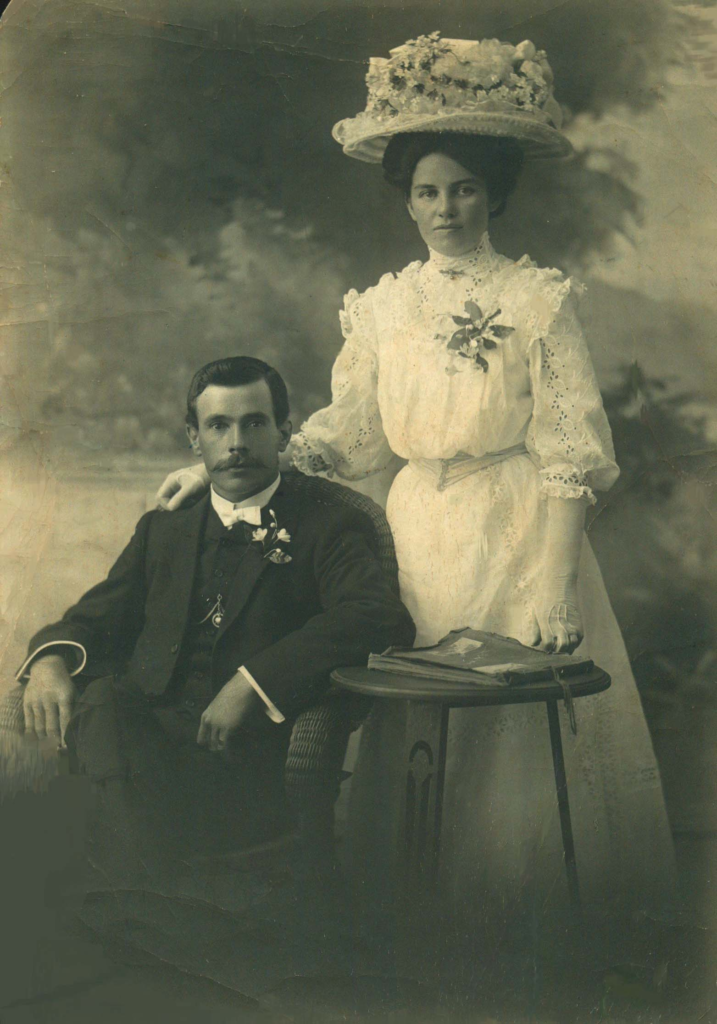
10 December, 1908.
Sadly, Sarah’s father James Murray died six months later from drowning in Cains Lagoon in Hodgson in June 1909.
Family Life on ‘Lanreef’ – originally ‘Fernvale’.
We continue Alf and Sarah’s life with more from Geoff Johnson’s ‘Mate’s Story’:
My mother Sarah Murray, whose parents lived in Hodgson, came to live on the property and was able to take up a block of land of 160 acres next to my father’s bringing the total area now to 800 acres. There was always a lot of mystery as to how she was able to hold this block of land in her name as it was claimed that this holding had living conditions included in the lease. Maybe this has something to do with the fact that a small slab hut complete with a bed and stove was duly built and around the hut a few empty food tins were scattered. The hut was called the ‘alley’ and my mother was known as ‘Sally from the Alley’. This particular portion of the property was always referred to as the Alley paddock for as long as I can remember.
The original homestead, if it can be called such, comprised two rooms and was built on Dargal Creek by Uncle Fred and Dad using cypress pine cut from the holdings. The structure was later dismantled and relocated on high stumps and duly extended to cater for our family needs. The collective holding was named ‘Fernvale‘ but later changed to Lanreef‘ (1927) after the Post Master Generals’ department installed a public telephone at the house and, as there was a Fernvale in the Brisbane Valley, we had to change our property name. ‘Lanreef‘ was derived from the letters of Fernvale and the only letter that couldn’t be used was the ‘V’.
‘Mate’s Story’ by Geoff Johnson.
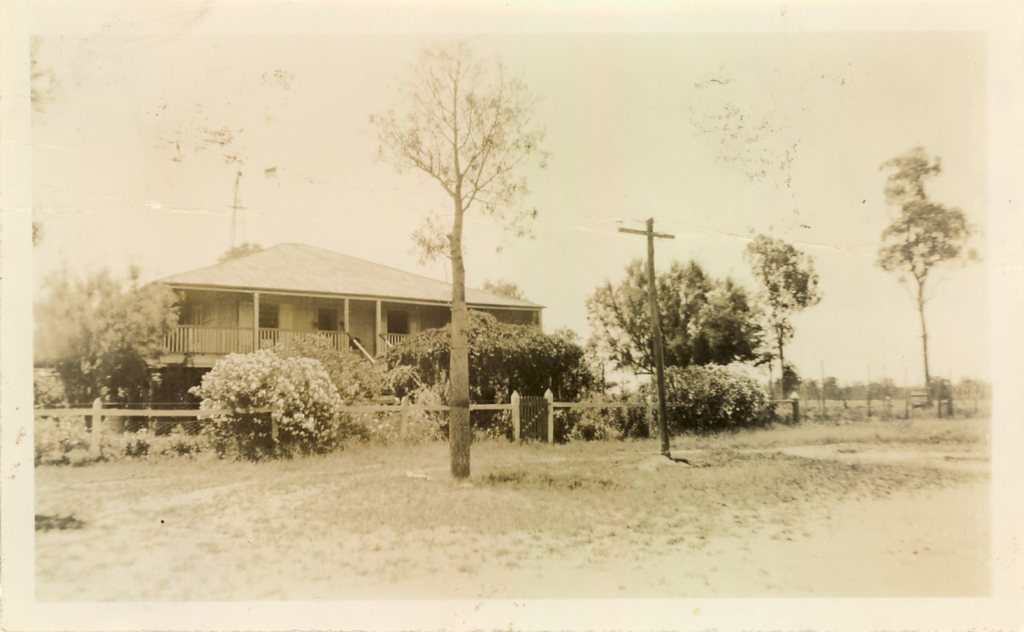
As usual with families back in the late 19th and early 20th century, children quickly followed a marriage. This was not different for Alf and Sarah. Their first son, Leonard George was born in October, 1909 and quickly followed by Ronald Alfred (1911), Aubrey Reginald James (1913), Mervyn Gibson (1915), Wallace Edgar (1918), Sybil Mary (1920), Geoffrey (1922) and Keith Coupland (1924). The pattern of a child every two years was usual back then.
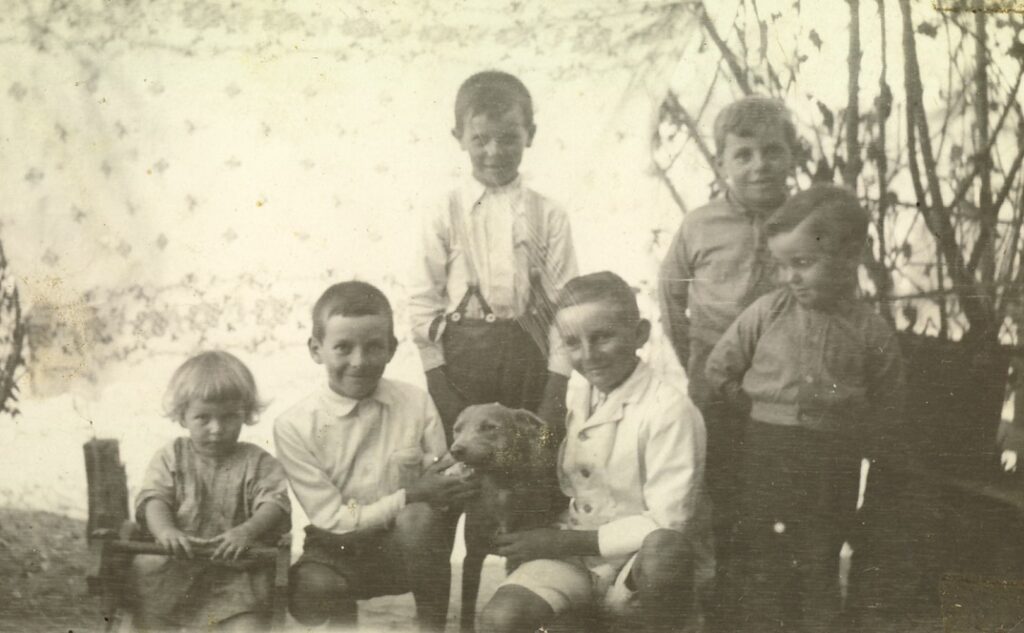
C1921-22.
Alf’s father George, died in 1912 and Alf continued working the property.
One of the big problems facing the property owners was the prickly pear.
Prickly Pear
The following is taken from an article at ‘Qld Historical Atlas. www.qhatlas.com.au.’
The prickly pear came out with the First Fleet as the scale insect that lived on the pads of the pear produced cochineal – a red dye – which was necessary for dying the red coats of the British soldiers. Captain Arthur Phillip had collected a number of cochineal-infested plants from Brazil on the way out to start a cochineal industry in Australia as only Mexico, Portugal and Spain had a cochineal dye monopoly at the time. As with a lot of introduced things, the prickly pear got out of control.
The prickly pear was sometimes used as fences, but it was also valued in drought as the pads had a high water content. However, the fruit was relished by birds who spread the seeds widely and remained viable for many years. Even semi-digested pads consumed by cattle still sprouted. It took a stronghold in brigalow forests of central and southern Queensland, and by 1900 pear covered 4 million hectares, where it was not an obvious problem. However after the 1901-02 droughts, when feeding prickly pear to livestock became widespread, it began to establish in prime grazing land, and by 1920, was estimated to be spreading at a rate of 400,000 hectares a year.
The Queensland Government encouraged settlement of infested land, through legislation and incentives, but few settlers succeeded uncomplying with else conditions to clear the pear and forfeitures of land were rife. for those who managed stock on pear infested land, there were additional problems. Horses used for mastering cattle had to have pear thorns pulled out of their legs after each ride or wounds became epic, and sheep shearers wore leather chaps, armlets and gloves to protect themselves against the spines and fine irritant hairs.
Manual controls of the pear were digging up , burning and crushing pear, even poisoning with arsenic pentoxide, which was highly toxic. A Commission was established and visited India, South Africa and the Americas, where prickly pear had originated. Many insect and fungus species were tried out and, finally, after interruption of World War I, in 1925, eggs of the Cactoblastis cactotum moth were imported from Argentina. The moth is native to South America, where the larvae feed on a variety of prickly pears. From 2,750 imported eggs, over 3,000,000,000 eggs were bred and distributed in the infested areas. Within seven years of first release, the last original pear areas in Queensland were destroyed, and the way was open for closer settlement and agricultural development in some of the most fertile lands.

Courtesy of Queensland Historical Atlas, 2020.
The map above shows that between Roma and Mitchell, there are areas of dense (red) and scattered (pink) pear. Hodgson is very close to Roma. In some of the articles in the Western Star & Roma Advertiser on the Land Court rulings for Alf and his father George, their land was listed as ‘Prickly Pear Infested’.
‘In about 1928, the Cactoblastis insect had been brought into the country in an attempt to check the spread of the prickly pear. I can clearly remember that the eggs were sent to us in boxes about the size of a shoe box and we had to distribute them about where the pear was thickest. These boxes containing the larvae eggs were sent to Hodgson Railway Station and came per the mailman from there, as did our bread, mail and anything else that was needed on the property. It was calculated that these eggs would hatch about a week after they arrived at their destination but , at times, the estimate time of arrival of the grubs was not accurate. I can remember the bread bag and mail being being literally covered with these minute brownish black grubs, which had to be promptly disposed of to the closest patch of prickly pear. To say that these insects transformed the county would be an understatement as in the course of a few year the pest was reduced to just a few odd patches.
‘Mate’s Story’ by Geoff Johnson.
We continue with more of ‘Mate’s Story’ with Alf and Sarah acquiring more land.
In 1933 there seemed to be a major movement in land sales, with some landholders purchasing neighbouring properties. My Father was instrumental in buying three such neighbours. (This was actually in 1929/301). One of these properties which belonged to my father’s brother, Uncle Fred , had a four bedroom house erected on the bank of the Dargal Creek and we dismantled it and made a shearing shed adjacent to Lanreef house. On finishing building the shed and yards we obviously needed another toilet structure near the shed and it was duly constructed and completed on the day the luxury liner Queen Mary was launched. Naturally the structure was christened the ‘Queen Mary’ and later it was common to be asked, “Where’s so and so?” and get the customer response, “Oh, he’s on the Queen Mary.”
‘Mate’s Story’ by Geoff Johnson.
School
Schooling was a big problem, particularly for my eldest brothers as the nearest one was ‘Dargal’ some six miles away, and it was not for some years that the government saw fit to sanction the erection of a provincial school. Under this arrangement, the parents had to supply and erect the building and the government would supply the teachers and the furniture and books. The school was erected at the boundary of ‘Lanreef’ and the structure was a room about 14 feet x 12 feet (4.3 m x 3.6), made of cypress pine slabs split with a broad axe and laid one on top of the other to form the walls with a corrugated iron roof. The most uncomfortable days were those in winter when the wind blew cold from the south or west and would whistle through the cracks between the rough hewn slabs. In about 1928, it became necessary to move the school to a site about four miles west of ‘Lanreef‘ homestead.
Mate’s Story by Geoff Johnson.
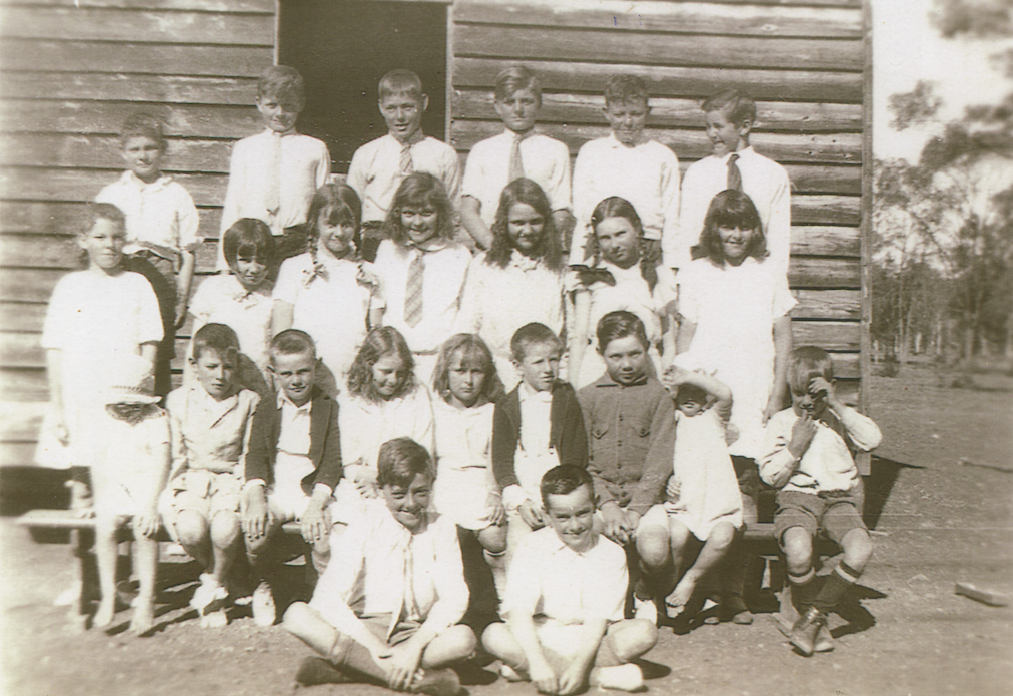
Geoff (front row right), Keith (2nd row, 3rd from left), Sybil (3rd row, 3rd from left).
However, even with shifting the school, by about 1933 there were only about six children in attendance. Geoff continues:-
At the time of the school closing, there were only six pupils attending, including my younger brother Keith and myself. My sister Sybil having been sent to boarding school in Toowoomba at Holberton Street, Rockville. In early 1934 my father brought a house and a 12 acre block of ground on the then outskirts of Toowoomba. It was here I attended School for the next three years. For two years, I attended Rockville State School and then Toowoomba Grammar School for one year in 1937.
‘Mate’s Story’ by Geoff Johnson.
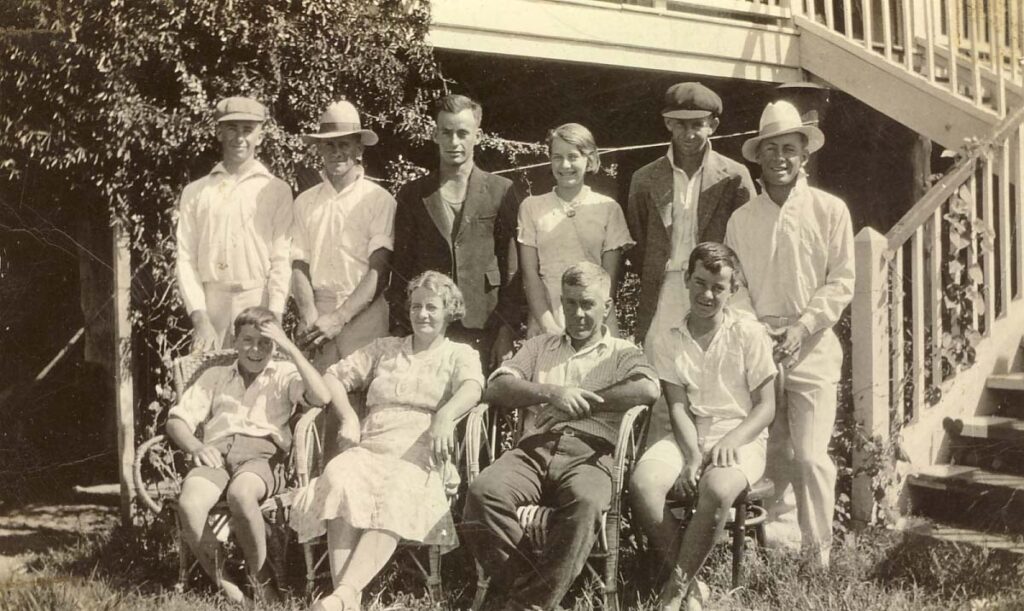
Back Row: Wadj, Aub, Ron, Sybil, Len, Merv.
Front Row: Keith, Sarah, Alf and Geoff.
c1934-5.
In 1937, Alf applied and received approval to the Bungil Shire Council for an extensions of the telephone line from ‘Lanreef’ to his brother-in-las Alf Warner at ‘Allandale’ – a distance of eight miles west.2 A grand-daughter of Alf can recall saying her father travelled to the Kingsvale School with his brothers and sisters in a sulky or on horse-back.
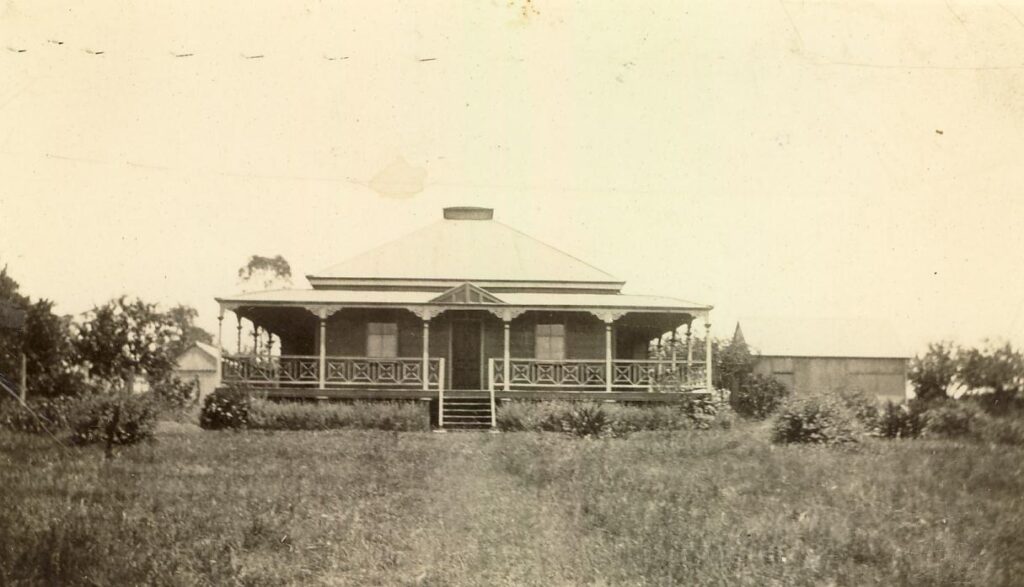
c1933.
It must have been hard for Sarah to go to Toowoomba with the three children and leave Alf and some of the sons at ‘Lanreef’. Luckily, Ron was engaged to Violet Richardson so Alf and Sarah asked them if they would get married, and would Vi look after the household while Sarah had the children in Toowoomba. Vi agreed and she and Ron were married. they stayed at ‘Lanreef‘ for the year 1935-36. Sarah then put the children into boarding school, Sybil to Fairholme and Geoff and Keith to Toowoomba Grammar School and returned home.
Interesting Recurring Article in Western Star & Roma Advertiser
One of the interesting articles I have found in the Western Star & Roma Advertiser was the clippings for the women attending the Country Women’s Association (CWA) restrooms. As you can imagine back in those day, there were no public toilets and no shopping centres with public toilets. The only toilet available was at the hotel and no woman would go in there alone.
A little history first. The first restroom was opened in June 19243 in the house of Mrs Edwards of Arthur Street. It was a place where women could not only visit the restroom but take their children, leave parcels etc. It was rented at 10 shillings a week payable by the CWA and for a small fee Mrs Edwards, who was also a member, would provide a cup of tea.
By 1940, a room had been rented in the School of Art Hotel. It was comfortably furnished with a settee, writing desk with stationery, pen and ink. A primus kettle, teapot, cup and saucers, etc., tea and sugar were provided, also hadn’t basin and towels, and two cots for the use of mothers attending the Baby Clinic , which was in the room opposite.4
Women who attended this room signed an attendance book. Rather than giving the number of attendees in a certain week or month, the Western Star & Roma Advertiser published the names of the women in the personal column. There are many listings for Sarah and her daughter Sybil and other female relatives. Over several years, Sarah was the President and Sybil was either secretary or treasurer.
Household Chores
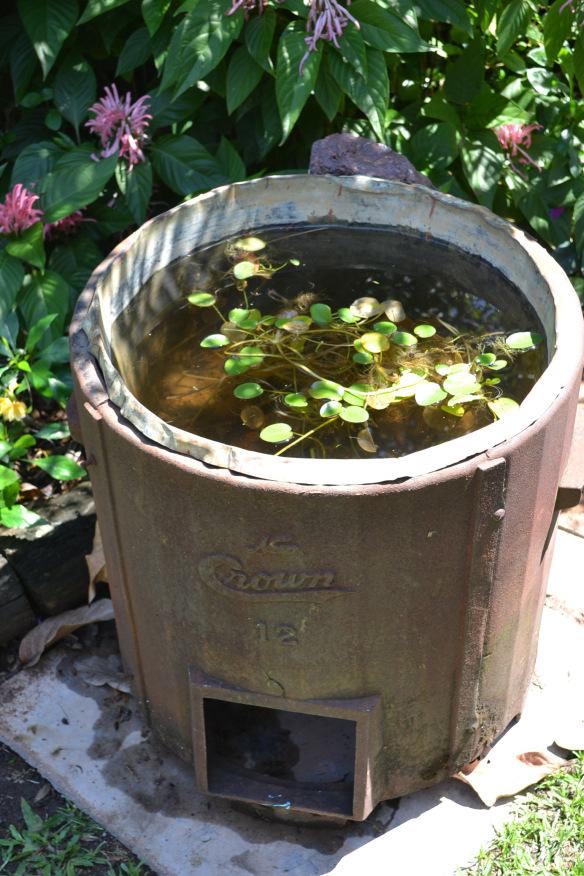
Imagine – fire below, chimney at back and
clothes in large tub.5
My mother, Sybil, was the only daughter and I remember her telling me of her younger life at ‘Lanreef‘. Below are my memories and I have interspersed them with extra information.
There were set days of the week for house-keeping jobs, probably similar to today but slightly different. Two days were set aside for large loads of washing, usually Monday and a day later in the week. Imagine – there were seven sons – five older than my mother – and two younger, then there was Alf, Sarah and some of the time, the school-teacher, so eleven people. The older boys played cricket and tennis on the weekends and would have whites to wash on the Monday. And, as well as clothes, there would be all the sheets, towels, tablecloths etc. The washing would have been done in a copper which was a copper tub, over a fire to heat the water and then rinsed in one or two tubs. The Whites would have been washed first, lifted out with a stick and put in a basket and taken to another tub, sometimes concrete or tin, and then rinsed in cold water in which blue had been added. Laundry bluing was made of a colloid of ferric ferrocyanide (blue iron salt, also referred to as ‘Prussian blue’). Blue colourings have been added to rinse water for centuries to stop white clothes from yellowing. The Reckitts blue I remember my mother using was a lump about 25 centimetres thick, which was enclosed in a piece of cotton fabric tied with string, and then swished around the rinse water until the water was blue. After rinsing, the clothes were put through a hand-wringer to squeeze as much water out as possible and then pegged onto wire lines which were strung between two posts. Some clothes were just washed in tubs using a washing board, which is a ribbed board where the clothes are rubbed against to dislodge the dirt. The really dirty work clothes were usually put through the copper first. Some clothes had to be soaked in starch so they would be stiff when ironed to keep their shape.
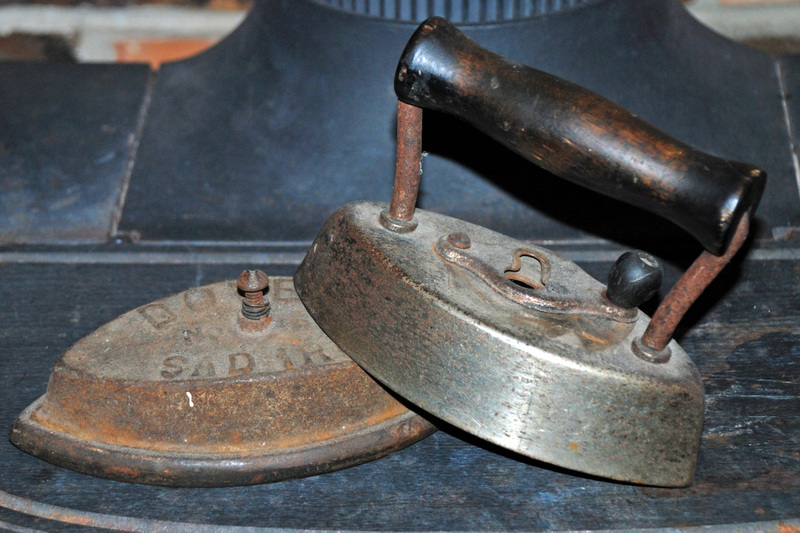
Another day was set aside for ironing – usually Tuesday. Irons were made in two pieces, the handle part and usually two heavy bottom parts which the handle could clip on to. One bottom iron part would be heating on the stove while the other was used. The clothes were usually dampened by flicking water onto them the night before and being rolled up and this would then create a steam when ironed and help with the ironing. However, there would also be a ironing cloth which could be put over delicate fabrics so as the iron would not burn a hole in it. The irons were checked to see how hot they were by flicking a wet finger against the bottom, and if they sizzled, then they were ready, however, you would always check them on a piece of cloth to make sure they were not too hot. Ironing could take up most of the day to do.
Wednesday was for cleaning the house and either sewing, darning etc., or baking and bottling. Sarah was a great craftswoman. She had been taught by her mother, Emily, and it was handed down to my mother. Between them, they made their own dresses, blouses and skirts, underwear, gloves and handbags, as well as the shirts and trousers for the men. They made their own felt hats and also made and embroidered the tablecloths, napkin ware and clothes. They made lace collars for dresses and blouses and lace gloves. They could also knit and crochet. And, of course, there would always be darning and mending to do.
Alf and Sarah had a good vegetable garden and fruit trees and a lot of the harvest was bottled for later use. Even though one day was usually a big baking day with bread, cakes, biscuits, scones etc being made for several days, there would also be the making of butter from the milk collected from the cow, or the salting and/or roasting of freshly killed beef or sheep.
And all the days would be filled with three meals to be made, morning and afternoon teas to be prepared, extra washing and other household chores. Never a dull moment.
As mentioned above, Vi took on the household work while Sarah looked after the three youngest children in Toowoomba for their schooling in 1935-36. Ron and Vi’s story is written in a family book and they kindly gave me permission to use her notes of her time at ‘Lanreef‘. These notes really tell the story of what a woman’s life was like in the 1930’s and show how lucky we are today with all the mod cons we have. Some of what is written is similar to my memories from my mother but I have included them as well as they are in Vi’s voice. A couple of things to remember while reading about this time for Vi, she was a young city lady and was housekeeping for seven adults. She was newly married in February 1935 and had her first child in December 1935, so was doing this heavy workload throughout her pregnancy.
Notes from my time working at ‘Lanreef‘.
“I had no time to be bored or lonely at ‘Lanreef’, there was so much to do. There were seven adults in the household. Ron, four of his brothers (Len, Aub, Merv and Wadj) their father and myself. – no mod cons.
All the washing was done by hand. There was a copper and two big round tubs. There was a bench under the house with a tap over it. If one tub was put under the tap, the other had to be filled by a bucket. To empty the tubs, I used a dipper and bucket and would throw the water around under the house to help keep the dust down.
The washing took nearly all day. There was always either tennis or cricket on Sunday so there would nearly always be five pairs of cream trousers as no one wore shorts for tennis or cricket. The shirts were all good dress shirts that had to be ironed. If there was a dance at the weekend, there would be extra good shirts as well as five suits to clean and press. We were too far away to send them to dry cleaners. This was in addition to all the household linen and work clothes.
The ironing took up most of the next day. Flat irons were heated on the wood stove which was hot work especially in summer. The stove should have to be kept hot to heat the irons and I could not stand in the breeze if there was one, as this would cool the irons too quickly. All good clothes were ironed as there were no non-iron tee-shirts in those days. All linen that was put away in the linen cupboard with the exception of sheets and towels, also had to be ironed.
There was always mending of worn or torn clothes and darning of socks to be done. Darning was an evening chore after tea. With so many men in the house cleaning and cooking was a major chore. The boys all had to make their own beds and help with the washing up after the evening meal. I would get a break from the cooking when the men were camped out while either ringbarking or fencing too far from home to come back each night.
Our lighting consisted of a Gloria Light in the kitchen dining room area that had to be pumped up and burned a refined fuel mix. Kerosene lamps including standard lamps and hurricane lamps which had a handle to carry them around, lit all the other areas.
There was no refrigerator instead evaporation was used as a cooling method for all food. We had a cooler safe that was like a three shelf cupboard with gauze sides, a shallow dish-like top and another dish under the bottom the top was filled with water, towels were hung all around their tops in water and the other end in the botton tray so that the water filtered down and the towels stayed moist all day. An earthen-ware crock, placed in a shallow dish filled with water, was used for storing butter. A cloth was draped over it with the ends in water providing the same evaporative cooling method.
Drinking water was kept cool by the use of water bags. These were canvas bags attached to a wire frame that would be filled with water and then hung in a breeze, if possible. The water would moisten the canvas and the evaporation effect would cool the water in the bag. These same canvas water bags would be seen hanging from horse saddles, wagons and the bumper bars of cars and trucks. No one ever left home without a filled water bag.
The men all liked to have a cooked breakfast each morning. They would have porridge and then any of bacon and eggs, chops, lambs fry and bacon or fritters made from leftovers. They also had toast.
Lunches had to be cut for the men to take with them as they very seldom came home in the middle of the day. Sandwiches with meat were a must as well as some cake. The evening meal was always a hot meal of meat and vegetables followed by a pudding of some sort. We grew our own vegetables when we could and had a few fruit trees. In the summer, it was too hot to grow vegetables so we used dried peas and beans. Pumpkins were always plentiful as they were home grown and stored. Surplus were give to the stock when a new crop was picked. We seemed to be able to grow carrots all year. Potatoes were purchased by the bag.
We killed our own stock for meat – mutton in the summer and beef in the winter. A portion under the house was enclosed to make a meat room. It had gauze walls and a door. Fresh meat could not be kept for long and so most meat had to be either put in brine or dry salted. The dry salted meat would shrink and look and feel like a lump of hard dry leather. I had to soak it in water for a day before changing the water and boiling it.
‘Lanreef’ was the telephone exchange for the party lines in the district. Although there was not a lot of business, someone always had to be available to answer calls .”
Courtesy of Violet Johnson – wife of Ron Johnson and daughter-in-law of Alf and Sarah.
Work on the Land
While Sara, and later with Sybil helping her, was working inside, Alf and the sons were working outside on ‘Lanreef‘. as mentioned above and also in his father George’s story, the land had to be cleared of trees, roots and stones for the planting of crops which were later ploughed, sewn and harvested. Also prickly pear had to be cleared as much as possible and constantly maintained for pasture for the sheep and cattle. It wasn’t until the late 1920’s when the Cactoblastis moth was introduced and the pear was eliminated that this scourge was not a burden for the landowner.
From the Stock Returns below, Alf started with mainly sheep and some cattle in the early 1910’s. He developed a Hereford Cattle herd but also at the same time increased the property from 700 acres in 1913 to 10,000 acres by 1937.
There was a rapid increase in the dairying industry in the Roma Area in 1918 with some 360 dairies and 10,500 dairy cows being registered.6 Alf also must have had a small dairy herd as it was mentioned that he purchased a milking shorthorn bull from Beaudesert to introduce quality stock.
In the Stock Returns, alf started out with 10 dairy cattle in 1913, increasing to 35 in 1918 and up to 60 by 1922. But by 1926, they started decreasing back to 30 and by 1934 alf did not have any. Perhaps because dairy cattle take a lot of time, especially in the mornings with the milking and getting them into yards at night fall and with the increase in acreage of land, Alf turned his focus to cheep and cattle.
Alf increased his property from 700 acres in 1913 to 2,800 acres in 1916, to finally 10,000 acres in 1939. The large increase in 1939 was for Prickly Pear development blocks. Possibly these blocks had been nearly cleared of the pear by the Cactoblastis moth before alf bought them or a lot of work would have been needed on this land.
‘Lanreef’ had good wheat crops in the 1929 season harvesting 451 bags of wheat and with the district recording about 12 to 14 bushels to the acre.7 And in 1930, Alf received good prices for of AAA and AA bales of wool. AAA clip wool rating is one of the highest quality followed by AA.
There was always the continuous buying and selling of cattle over the years. One such time in 1939 had Alf buying nine stud cows and twelve stud Hereford heifers to increase his herd from the BelleVue Stud at Esk.8
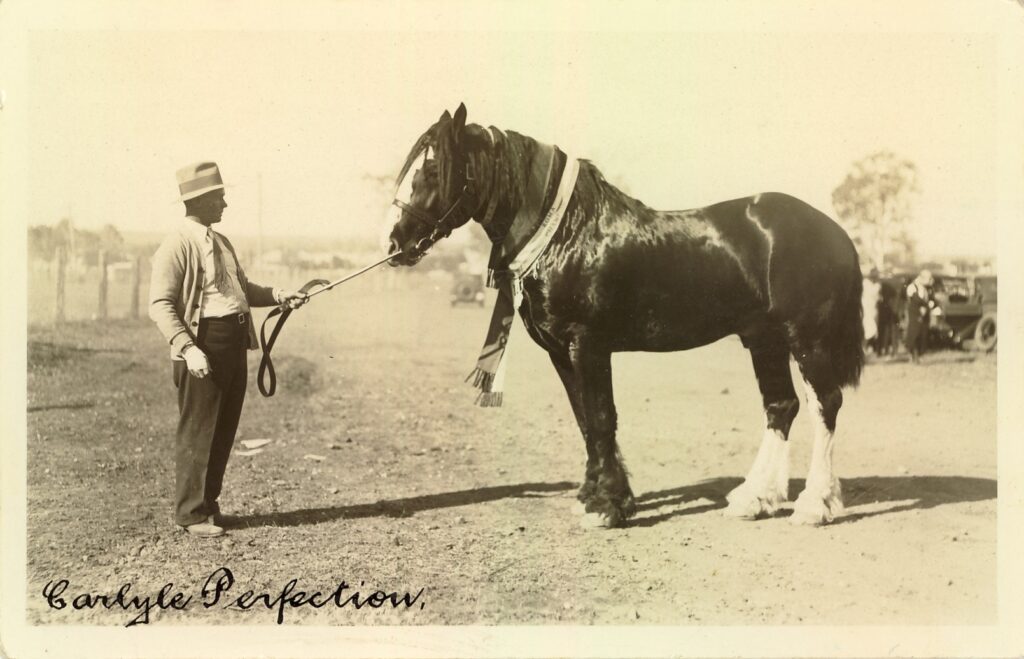
1934.
Obviously, Alf loved horses. One of his passions was his prize Clythesdales or draught horses. He no doubt inherited this from his father, George and possibly Uncle, George Coupland. Back in England his father had possibly worked for his father-in-law, John Coupland on his farm in Warwickshire around the time he was married, and they could have used draught horses. Or perhaps, it was when the Johnsons first arrived in Australia, and visited George and Lavinia Coupland outside Muswellbrook and stayed for some years. George Coupland, brother of Eliza Johnson (Alf’s mother), managed a property ‘Overton’ which had prize Clydedales. (A short version of George Coupland’s story can be found in the Children dropdown box at the end of his parents‘ story.) In 1933, Alf’s horse, ‘Carlyle Prince’, won Best Stallion owned in Maranoa and Champion Stallion at the Roma Show. And again in 1934, his horse ‘Carlyle Perfection’ won 2 prizes and Champion Draught Stallion.
Alf also had a few race horses over the years and entered them in the amateur races in Roma. As far back as 1918 with ‘Tara’ which won the First Aid Stakes in aid of the Roma Ambulance,9 to ‘Lanizan’ in the late 1930’s early 1940’s.10
To earn some money which there was no shearing, or clearing, ploughing, harvesting etc., the sons began a water boring plant. Ron was a water diviner and with his other brothers, they would find work in the district sinking bores for water. This was started in the 1930’s and continued into the late 1940’s with Geoff and Keith helping out after the war as the older brothers were away at other work or working their own properties.
Social Life
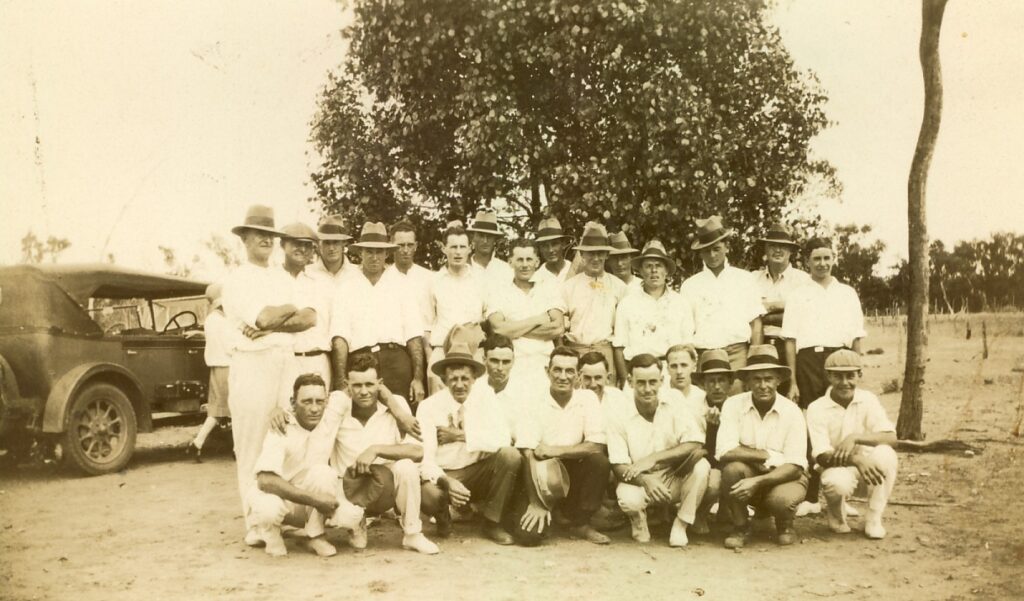
Back Row: Merv, centre with no hat and folded arms.
It wasn’t all hard work on the land. There were cricket matches on the weekends and most of the sons were involved in this over the years. Also there were dances at the Hodgson Hall and many social events. Tennis was a big thing in the district and ‘Lanreef’ had a tennis court next to the house and many a pleasant afternoon was spent there. Roma had a race track so there was usually a race event on the weekend if no sport was offering. And of course, there was the annual Roma Show which was held over several days in May.
World War ll
World War ll had a great effect on the family. Although the War started in 1939, the three bachelor sons, Len, Wadj and Geoff were not allowed to join being employed on the land and in the shearing industry, which was considered a reserved occupation. However, Len joined in July 1941 and was in the RAAF 8 Mobile Works Squadron. Geoff joined the RAAf in May 1941 and became wireless operator in Lancaster bombers from England over Germany. And Wadj joined in March 1942 and was with the Australian Army in the 4 Supply Depot Company AASC.
Sarah and Sybil contributed to the war effort by making knitting socks, gloves and scarves for the boys. A lot of these hand made goods were donated by the CWA to the war effort. I still have a copy owned by Sarah of the ‘Warworkers Woolcraft’ provided by the CWA filled with instructions for the making of socks, scarves, balaclavas, neck muffs, mittens etc. Another contribution made by the CWA women of Australia was camouflage nets and I remember my mother, Sybil, mentioning that she and Sarah made these nets. In the Roma CWA Annual Report for 1942, there was mention of 72 nets being sent to Victoria Barracks in Brisbane.11
It would have been a trying time for the family. Firstly, Sybil’s fiancé Lloyd Maiden (my Dad), a commando with the 2/4 AIF, was incommunicado for 4 months from the end of 1942 on Timor fighting the Japanese. The company was evacuated from Timor in February 1943. We then had Geoff going missing over Germany. His plane was shot down in a bomber raid in March 1944. There was no news of Geoff for seven months until mid-September when he arrived safely back in England. He had bailed out of his bomber and along with another crew member, had been hidden by the Belgian Underground and spent a lot of time above the shop owned by the four La Crosse sisters. While staying with the la Crosse sisters, Geoff and Charlie were taught rug making and needle work to occupy themselves. Geoff became very good at tatting and brought home two table centres that he had made.
Life Goes On
Life continued on after the war with all the children except Len marrying and moving to their own properties.
In March 1949, we have the first hint of Alf and Sarah shifting from ‘Lanreef‘. Alf purchased a top Hereford stud bull, Colly Creek Electric, for 700 guineas subject to the condition that he obtain possession of the property ‘Coongoola‘, the property and stud of Mr . H. Edwards for which he was negotiating.12 ‘Colly Creek Electric’ was an outstanding bull and had been junior champion at Sydney and made the record price at auction for a bull under 12 months, of 1600 guineas.13
Alf was successful in purchasing ‘Coongoola’ in April of that year.14 ‘Coongoola’ , a property of 1,448 acres, was near Colloseum, just outside Miriam Vale in Queensland. It was situated in country which was a Hereford stronghold, and had a constant demand for its stock and exercised a big influence on the central coastal cattle industry.15
Alf then set about selling ‘Lanreef’ and was successful in this and sold it to a New South Wales buyer in November 1949.16 The Qld. Country Life mentions that ‘Lanreef‘ ‘comprises highly improved brigalow and belah country with some sandal wood and box’.
However, Alf and Sarah were only at ‘Coongoola’ for a short 20 months. In December 1950, ‘Coongoola’ had been sold. Why did they only have ‘Coongoola‘ for such a short period? I believe that Alf started to suffer ill-health. He was diagnosed with Coronary disease in about November 1950 but probably would have been suffering before the diagnosis. Perhaps he even sold ‘Lanreef‘ as it was so large and the workload was too great.
Or perhaps there was another reason. There was mention in Geoff Johnson’s book ‘Mate’s Story’ of dividing the property between Geoff and Keith but ‘obstacles always seemed to arise with that idea so it was decided that ‘Lanreef be sold’.
Alf and Sarah returned to Roma from Miriam Vale and set up home at 24 Quinton Street, which they had bought from their son Geoff. They were only there a few months before Alf was admitted to the Roma Hospital on 24 April suffering from Pulmonary Oedema or excess fluid on the lungs. He died on 29 April 1951, aged 67 years, and was buried at the Roma Cemetery.
Sarah continued living at Quintin Street for a couple of years. Although she didn’t own any property, she still had cattle and sheep left to her by Alf. From the Stock Returns, we are able to see that she had over 300 cattle and up to 1,450 sheep. These animals were on agistment at her sons’ and son-in-law’s properties from Dulacca to Surat, north of Roma and Hodgson. By the end of 1953, Sarah had sold all the stock and decided to move to Toowoomba.
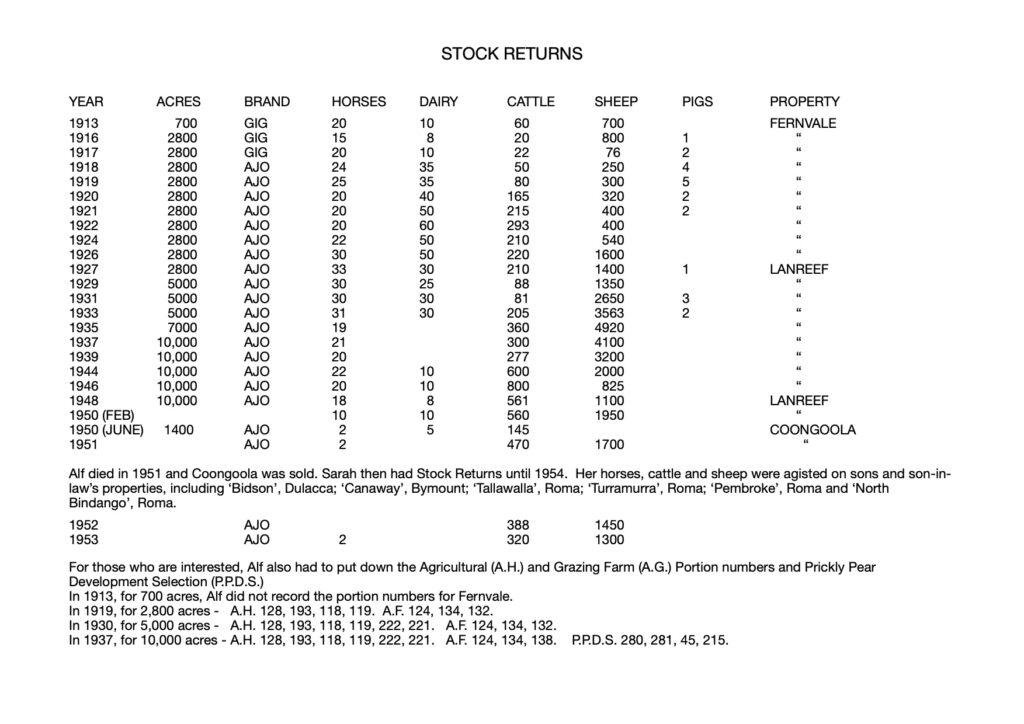
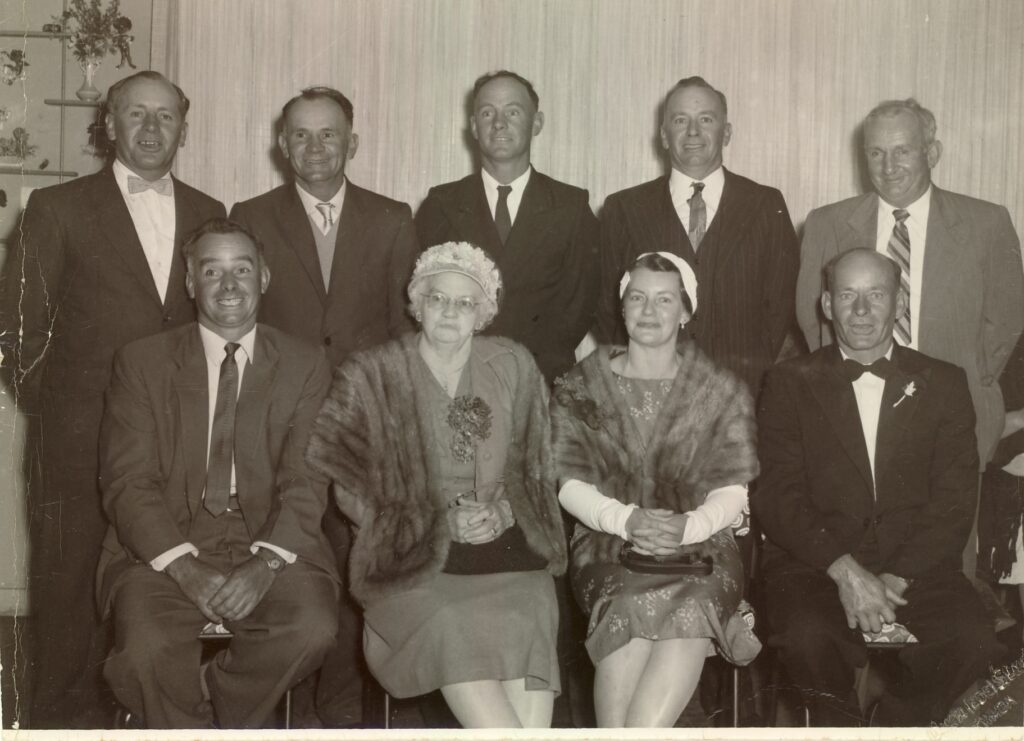
Back Row: Merv, Aub, Keith, Wadj, Len.
Front Row: Geoff, Sarah, Sybil, Ron.
1959.
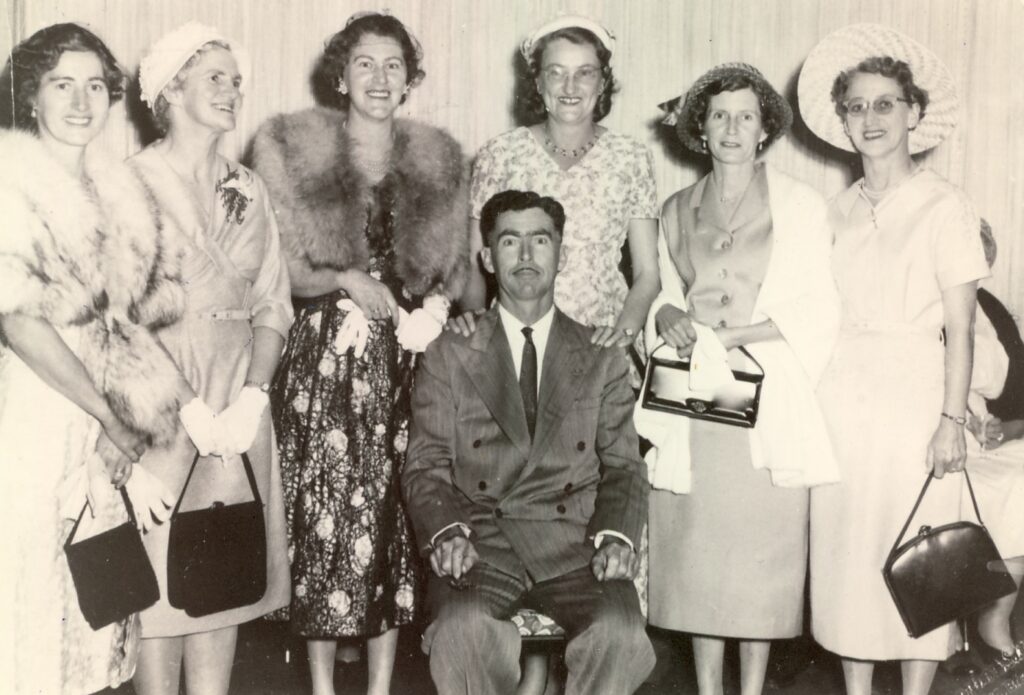
Back Row: Emily (Merv), Vi (Ron), Beryl (Keith), Glory (Geoff), Meg (Aub), Ivy (Wadj).
Front Row: Lloyd (Sybil).
1959.
The above photos were taken at one of the grandchildren’s wedding in 1959 in Toowoomba. There is a story about the expressions on some of the faces in the Out-Laws’ photo. Apparently Geoff, who was sitting next to his mother Sarah, had been really ‘enjoying’ the wedding and was quite happy. Sarah, being a strict Presbyterian, didn’t like alcohol so was a bit cranky about it. And Sybil, on Sarah’s other side, was trying hard not to laugh.
As for the photo of the In-Laws and Lloyd’s startled look? He always said (tongue in cheek) ‘Wouldn’t you look a bit startled being surrounded by all your sisters-in-law?”.
Sarah was only in Toowoomba for several years before moving to Douglas Street, Enoggera. However, at the end of 1959, Sarah moved back to Roma and bought a house at 146 McDowall Street, opposite the Police Station. Len, her oldest son and the bachelor, had his bedroom in a shed in the back yard and Sarah provided him with meals and did his washing etc. My mother Sybil drove the school bus 20 miles from ‘Bellevue’ to Roma and back each morning and afternoon but would usually stay in one day a week to help Gran clean the house and do some washing.
Sarah fell ill in February 1963 suffering from gall-stones and high cholesterol. She was admitted to St. Vincent’s Hospital in Toowoomba and underwent an operation. She was here for several months and developed an infection from the operation . While in the last days of hospital, she developed a blockage in her main heart artery.
Sarah died in St. Vincent’s on 12 April, 1963. She was 75 years old. Her daughter Sybil was visiting her in Toowoomba at the time and Sybil’s husband, Lloyd, was the informant on her death certificate.
She was brought back to Roma for her funeral and was buried in the Roma Cemetery next to Alf.
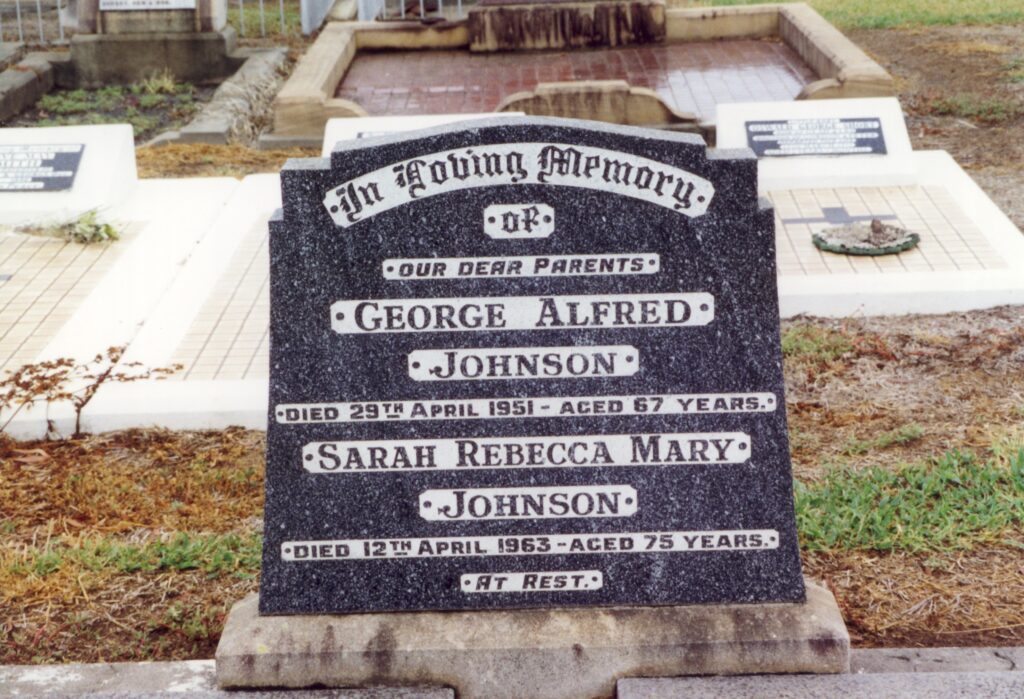
Roma Cemetery.
Memories
I lived with Gran in Brisbane at Enoggera in the first half of 1959 while I was at Teachers College.
Gran was never shy of speaking her mind. When Greg and I got engaged she happened to be at our place at Cambooya. It was the first time she had met Greg. She inspected the ring and said, “Well, at least it is a diamond.” She then asked when we were getting married. Her comment came back as “Well, I don’t want to hear of you getting married before that!” The implication was – don’t get pregnant before that.
While I was staying with her in Brisbane, I was not allowed to go out with a boy unless he had a church reference. Dad thought this was hilarious. He said the only church reference he could get was from the local priest who he played bowls with and drank with on regular occasions.
While staying there, I had a friend from school at Fairholme, Judy Jenson, staying there also. Judy was very shy and would blush at the mention of a boy. Gran mistakenly believed that if I went out with Judy I was safe. We used to go out together – split up – and meet up again just before going home.
Gran monitored what we had on our sandwiches each day for College. I liked peanut butter and honey or jam. I was told “You can have peanut paste or jam but on no occasion can you have peanut paste and jam.”
Our rooms were checked regularly to make sure that they were not only swept but dusted as well. If I came home from College and there was a big question mark drawn in the dust on my mirror, I knew I was in trouble and would have extra chores to do to make up.
Gran moved back to Roma in the middle of that year. I have always wondered what part the strain of having me live with her played in that move. For me, her moving was heaven because she would not allow me to live anywhere else while she was there in Brisbane.
Fay Hayden (nee Johnson). Grand-daughter of Sarah and Alf Johnson.
My memories of Grandma. When Paula and I came to Brisbane for boarding school in 1958 at St. Michael’s, Clayfield, I remember going to Enoggera with Mum, Dad and Paula and seeing television there for the first time. Clearly recall we watched the ABC.
While at boarding school, Grandma took us out several times. We went to church in Ann Street, at the Presbyterian Church, and also to the movies in Queen Street at one of those lovely old theatres, maybe the Wintergarden. We saw a movie with Lana Turner called ‘The Imitation of Life’.
Also Grandma was instrumental in arranging my christening at St. Michael’s Church of England School, as I had not yet been christened and she wanted that to happen.
I remember her as being very kind, and joking to me once if I stood up to eat my skinny legs might fatten up a little.
Sue Espie (nee Johnson) – Grand-daughter of Sarah and Alf Johnson.
Gran was a very loving person but could also be quite strict and wouldn’t put up with any nonsense, but was very fair. Well, I guess having seven sons, you can understand why. If you annoyed her she would tell you “You have vexed me!” or “I am very vexed!”- it was one of her favourite words. She often had a saying for different things like ‘Save your breath to cool your porridge’; ‘Wandering in like Brown’s cows’.
We remember her as being a great craftswoman, being able to sew garments and household items as well as knit and crochet. One thing I remember Gran making and I have never seen it since was a card basket. She often received and used post cards which she covered in hard clear plastic to protect them and these were sewn together to form a basket which was then lined. I distinctly remember Gran had a sewing basket made from these postcards or colourful clippings.
She was also a great gardener and loved flowers but also had a very good vegetable garden and fruit trees.
We would often go to Grans on Sunday either after early church when we mostly had brain fritters or the later church service and sit down to roast veggies, roast beef and Yorkshire pudding and always followed by dessert for lunch. We have never tasted better Yorkshire pudding since.
Jan remembers Grandad loved bush poetry and taught and expected Jan and her brother Rex, to learn ‘The Man from Snowy River’ and recite it for him. This was when the children were only about four or five years old. He was also very strict and believed in ‘speak when you are spoken to’, and you had to sit up straight at the table and not speak.
Jan Walker & Gillian Walters (both nee Maiden) – Grand-daughters of Sarah and Alf Johnson.
- Western Star & Roma Advertiser . Sale of property goods and chattels. 6 March, 1929. trove.nla.gov.au.
- Western Star & Roma Advertiser. 6 November, 1937. trove.nla.gov.au.
- Western Star & Roma Advertiser. 12 June, 1924. trove.nla.gov.au.
- Western Star & Roma Advertiser. 26 April, 1940. trove.nla.gov.au.
- troppont.files.wordpress.com/2012/10/dsc_0398,
- Western Star & Roma Advertiser. 27 February, 1918. trove.nla.gov.au.
- Western Star & Roma Advertiser. 12 January, 1929. trove.nla.gov.au.
- Western Star & Roma Advertiser. 28 october, 1939. trove.nla.gov.au..
- Western Star & Roma Advertiser. 15 June, 1918. trove.nla.gov.au.
- Western Star & Roma Advertiser. 12 April, 1939.trove.nla.gov.au.
- Western Star & Roma Advertiser. 8 May, 1942. trove.nla.gov.au..
- Qld. Country Life. 17 March, 1949. trove.nla.gov.au.
- Qld Country Life. 28 December, 1950.
- Qld Country Life. 7 May, 1949. trove.nla.gov.au.
- Qld Country Life. 28 December, 1950.
- Qld. Country Life. 1 December, 1949.trove.nla.gov.au.
